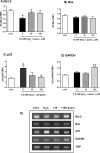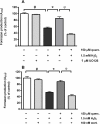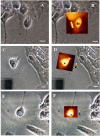Atomic force microscopy reveals new biophysical markers for monitoring subcellular changes in oxidative injury: Neuroprotective effects of quercetin at the nanoscale
- PMID: 30303965
- PMCID: PMC6179194
- DOI: 10.1371/journal.pone.0200119
Atomic force microscopy reveals new biophysical markers for monitoring subcellular changes in oxidative injury: Neuroprotective effects of quercetin at the nanoscale
Erratum in
-
Correction: Atomic force microscopy reveals new biophysical markers for monitoring subcellular changes in oxidative injury: Neuroprotective effects of quercetin at the nanoscale.PLoS One. 2019 Feb 6;14(2):e0212150. doi: 10.1371/journal.pone.0212150. eCollection 2019. PLoS One. 2019. PMID: 30726293 Free PMC article.
Abstract
Oxidative stress has been recognised as an important pathological mechanism underlying the development of neurodegenerative diseases. The biomarkers for assessing the degree of oxidative stress have been attracting much interest because of their potential clinical relevance in understanding the cellular effects of free radicals and evaluation of the efficacy of drug treatment. Here, an interdisciplinary approach using atomic force microscopy (AFM) and cellular and biological molecular methods were used to investigate oxidative damage in P19 neurons and to reveal the underlying mechanism of protective action of quercetin. Biological methods demonstrated the oxidative damage of P19 neurons and showed that quercetin improved neuronal survival by preventing H2O2-induced p53 and Bcl-2 down-regulation and modulated Akt and ERK1/2 signalling pathways. For the first time, AFM was employed to evaluate morphologically (roughness, height, Feret dimension) and nanomechanical (elasticity) properties in H2O2-induced neuronal damage. The AFM analysis revealed that quercetin suppressed H2O2-provoked changes in cell membrane elasticity and morphological properties, thus confirming its neuroprotective activity. The obtained results indicate the potential of AFM-measured parameters as a biophysical markers of oxidative stress-induced neurodegeneration. In general, our study suggests that AFM can be used as a highly valuable tool in other biomedical applications aimed at screening and monitoring of drug-induced effects at cellular level.
Conflict of interest statement
The authors have declared that no competing interests exist.
Figures







Similar articles
-
Quercetin attenuates cell apoptosis of oxidant-stressed SK-N-MC cells while suppressing up-regulation of the defensive element, HIF-1α.Neuroscience. 2014 Sep 26;277:780-93. doi: 10.1016/j.neuroscience.2014.07.036. Epub 2014 Aug 7. Neuroscience. 2014. PMID: 25108166
-
Neuroprotective effect of quercetin against hydrogen peroxide-induced oxidative injury in P19 neurons.J Mol Neurosci. 2012 Jun;47(2):286-99. doi: 10.1007/s12031-012-9737-1. Epub 2012 Mar 14. J Mol Neurosci. 2012. PMID: 22415355
-
Rosmarinic acid mediated neuroprotective effects against H2O2-induced neuronal cell damage in N2A cells.Life Sci. 2014 Sep 15;113(1-2):7-13. doi: 10.1016/j.lfs.2014.07.010. Epub 2014 Jul 21. Life Sci. 2014. PMID: 25058919
-
Quercetin in hypoxia-induced oxidative stress: novel target for neuroprotection.Int Rev Neurobiol. 2012;102:107-46. doi: 10.1016/B978-0-12-386986-9.00005-3. Int Rev Neurobiol. 2012. PMID: 22748828 Review.
-
A Critical Analysis of Quercetin as the Attractive Target for the Treatment of Parkinson's Disease.CNS Neurol Disord Drug Targets. 2022;21(9):795-817. doi: 10.2174/1871527320666211206122407. CNS Neurol Disord Drug Targets. 2022. PMID: 34872486 Review.
Cited by
-
Anti-Oxidative, Anti-Inflammatory and Anti-Apoptotic Effects of Flavonols: Targeting Nrf2, NF-κB and p53 Pathways in Neurodegeneration.Antioxidants (Basel). 2021 Oct 15;10(10):1628. doi: 10.3390/antiox10101628. Antioxidants (Basel). 2021. PMID: 34679762 Free PMC article. Review.
-
Neurotoxic Effect of Flavonol Myricetin in the Presence of Excess Copper.Molecules. 2021 Feb 5;26(4):845. doi: 10.3390/molecules26040845. Molecules. 2021. PMID: 33562817 Free PMC article.
-
Neurotoxic Effect of Ethanolic Extract of Propolis in the Presence of Copper Ions is Mediated through Enhanced Production of ROS and Stimulation of caspase-3/7 Activity.Toxins (Basel). 2019 May 15;11(5):273. doi: 10.3390/toxins11050273. Toxins (Basel). 2019. PMID: 31096598 Free PMC article.
-
Inhibition of Oxidative Stress and Related Signaling Pathways in Neuroprotection.Antioxidants (Basel). 2024 Aug 26;13(9):1033. doi: 10.3390/antiox13091033. Antioxidants (Basel). 2024. PMID: 39334692 Free PMC article.
-
Quercetin Is An Active Agent in Berries against Neurodegenerative Diseases Progression through Modulation of Nrf2/HO1.Nutrients. 2022 Dec 2;14(23):5132. doi: 10.3390/nu14235132. Nutrients. 2022. PMID: 36501161 Free PMC article. Review.
References
Publication types
MeSH terms
Substances
LinkOut - more resources
Full Text Sources
Medical
Research Materials
Miscellaneous

